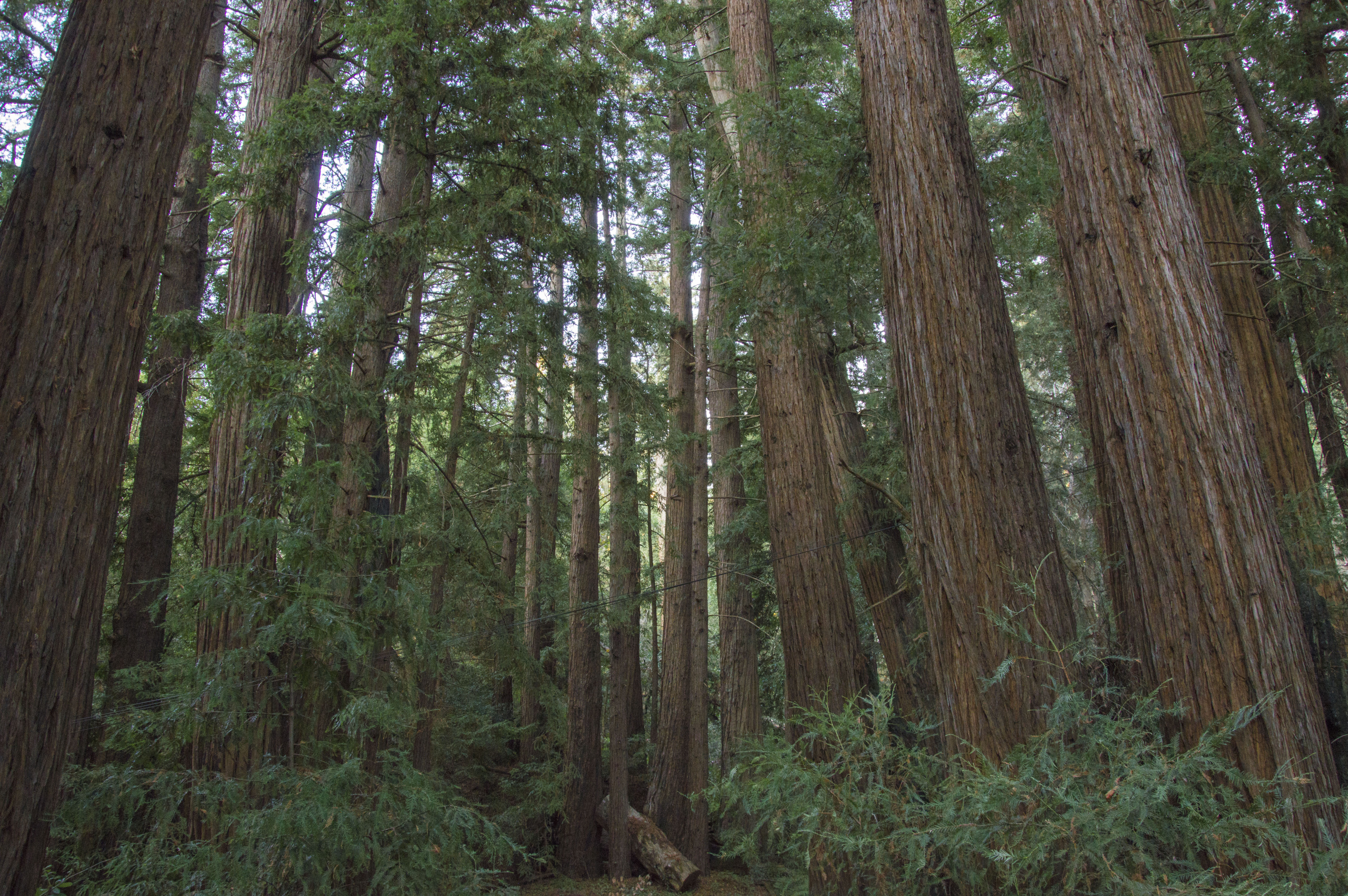Sequoia sempervirens
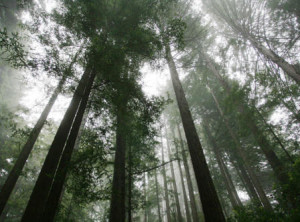
Photo by Greg Hirson
Coast redwoods the tallest trees in the world, towering 300-350 feet tall and sometimes even reaching heights of 375 feet – taller than the Statue of Liberty! The Los Padres contains the southernmost grove of coast redwoods, and while still towering giants, redwoods in the Los Padres are smaller than their northern counterparts, reaching heights of around 200 feet because of the warmer, drier climates here.
In addition to their legendary height, coast redwoods are also recognized for their long lives. Coast redwoods in old-growth stands are often recorded to be over 1,000 years old, yet the oldest recorded coastal redwood was nearly 2,200 years old! The longevity of coast redwoods is attributed to their resistance to fire, and the high level of tannic acid in their bark and heartwood gives redwoods a powerful resistance to disease and insect infestations as well. This ancient, giant of a tree is not protected under the Endangered Species Act, but is listed as vulnerable on the IUCN Red List (International Union for the Conservation of Nature and Natural Resources).
What’s in a Name?
The coast redwood is one of three species of trees referred to as “redwoods,” the others being the Giant Sequoia, Sequoiadendron giganteum, found only in the Sierra Nevada, and the Dawn Redwood, Metasequoia glyptostroboides, found native in only one remaining forest of about 5,000 trees in China. The scientific name Sequoia comes from the Cherokee Indian chief Sequoyah and sempervirens is Latin for “always green.”
Habitat
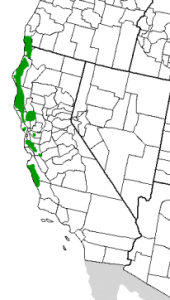 Coast redwoods are found in a narrow band along the California Coast from around the Oregon border to the Santa Lucia Mountains in southern Monterey County. Throughout the northern portion of the Los Padres, redwoods can be found in small groves near the ocean or in foggy canyons, around creeks, and in other areas that meet its requirements of cooler temperatures and sufficient rainfall. Fog is especially important in the summertime, as it helps maintain soil moisture during summer. The dryer, warmer climate of the Los Padres restricts available redwood habitat to mostly isolated locations, like north-facing slopes or canyon bottoms. This isolation at the southern edge of the redwood’s current range may cause the redwoods in the Los Padres to be genetically unique from northern populations of redwood.
Coast redwoods are found in a narrow band along the California Coast from around the Oregon border to the Santa Lucia Mountains in southern Monterey County. Throughout the northern portion of the Los Padres, redwoods can be found in small groves near the ocean or in foggy canyons, around creeks, and in other areas that meet its requirements of cooler temperatures and sufficient rainfall. Fog is especially important in the summertime, as it helps maintain soil moisture during summer. The dryer, warmer climate of the Los Padres restricts available redwood habitat to mostly isolated locations, like north-facing slopes or canyon bottoms. This isolation at the southern edge of the redwood’s current range may cause the redwoods in the Los Padres to be genetically unique from northern populations of redwood.
The Resilient Redwood
When it comes to outcompeting other species in the undergrowth for a spot in the canopy, coast redwoods have many advantages. A mature redwood can release around six million seeds a year and although only five percent or less of them germinate and fewer become saplings, those that do can endure in the shade of the undergrowth for hundreds of years waiting for the slightest opening in the canopy. Redwood saplings are able to grow in deep shade, but with plenty of sun and wet soil a sapling can grow six feet in just one growing season, easily outdistancing other species in the undergrowth.
The coast redwood not only outcompetes other undergrowth plants it also often outlives them by readily adapting when conditions change. In the case of fire, the coast redwood has many adaptations that enable it to live. For one thing the fire resistant bark of the coast redwood can be up to 12 inches thick, acting as a shield against fire. This is why many of the coast redwoods you see have black scars running far up their trunks, having endured many fires throughout their long lives. In addition, its wood does not contain the flammable resins that cause many other conifers to burn easily. Second, the root system of the coast redwood enables it to adapt to changing soil conditions. Often the canyons where redwoods reside are subjected to floods of mud after a fire burns the vegetation from slopes and winter rains wash the soil and debris into the canyons. The coast redwood has the ability to create new, higher root systems following the deposition of sediment around its base, meaning it can outcompete many other species that are smothered by such conditions.
Coast redwoods that have fallen, been logged, or have been badly damaged by fire do not always die. A damaged coast redwood has the ability to regenerate by sprouting clones from its stump or the dormant basal buds located on its roots, taking advantage of the established root system to grow more rapidly. These sprouts form a ring of trees, often called a “fairy ring,” around the stump of their parent tree. Recent fires in the northern Los Padres give forest enthusiasts a unique opportunity to see the resilience of the redwood’s fire-resistant bark, as well as its ability to sprout back after a fire.
Unique Redwood Stands in the Los Padres
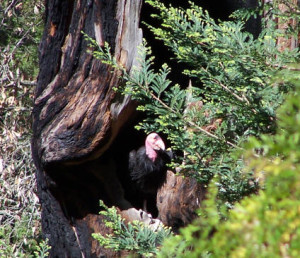
An endangered condor peers from a nest in the cavity of a redwood in the Ventanta Wilderness. Photo by Joseph Brandt/Ventana Wildlife Society.
The Los Padres National Forest is home to roughly 6,621 acres of redwood forest cover, as well as the southern tip of the coast redwood’s current range. Located in Monterey County, the Southern Redwood Botanical Area (also known as the Southern Redwood Special Interest Area) encompasses the southern most stand of natural redwood trees and was designated for its unique botanical values. This area is small (17 acres) and narrow, since redwoods at this latitude usually occur along streams, and is located in the Little Redwood Gulch watershed adjacent to the Silver Peak Wilderness.
Amidst the coast redwood forests of California and Oregon, old growth redwood stands are rare because over 95% of the original, virgin redwood forests have been logged. However, protected in the Ventana Wilderness of our National Forest in the deep canyons formed by the Big Sur and Little Sur Rivers lies some of the remaining virgin stands of coast redwood—just a beautiful hike away. Other visitors to the Ventana Wilderness include the banana slug, the trowbridge shrew, and even California condors, which have been found nesting in the cavities of redwood trees in the Ventana Wilderness of the Los Padres.
Ghost Trees
Albino redwoods, or “ghost trees,” are the only white evergreen trees in the world. These redwoods, with their white-colored needles, are unable to produce chlorophyll, the pigment that gives plants their green color and allows them to photosynthesize, or obtain energy from sunlight. The albino redwood is thus dependent on the parent tree from which it sprouts, and is stunted in its growth.
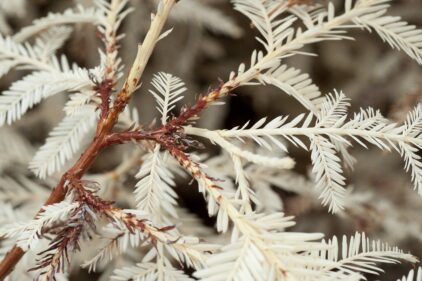 Albino redwoods are scattered throughout Oregon and California, with about 400 known trees. The southernmost “ghost tree” is located in the Los Padres National Forest along the Big Sur coast. Read more in the SLO New Times and the San Jose Mercury News about the rare “ghost trees” of the Los Padres National Forest.
Albino redwoods are scattered throughout Oregon and California, with about 400 known trees. The southernmost “ghost tree” is located in the Los Padres National Forest along the Big Sur coast. Read more in the SLO New Times and the San Jose Mercury News about the rare “ghost trees” of the Los Padres National Forest.

